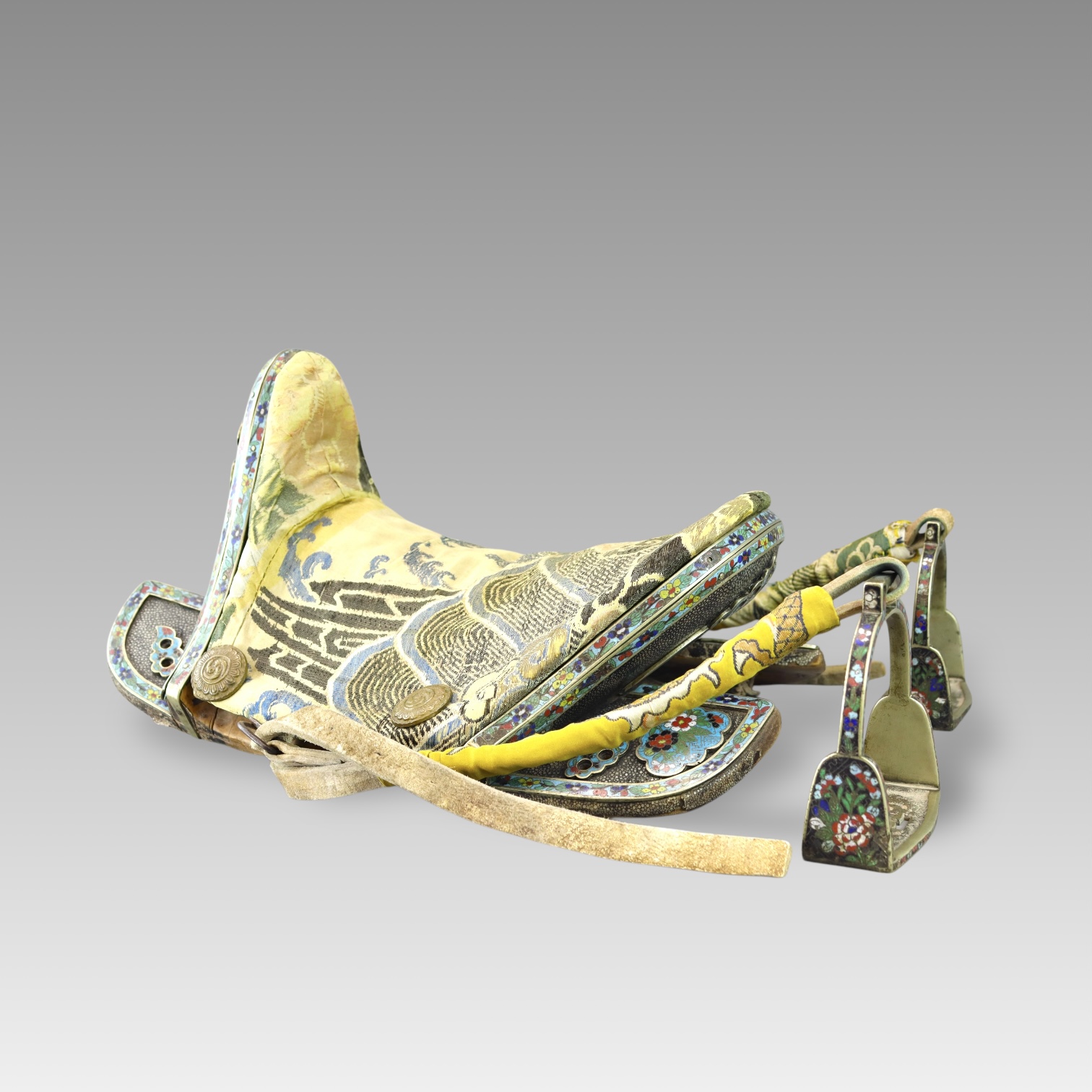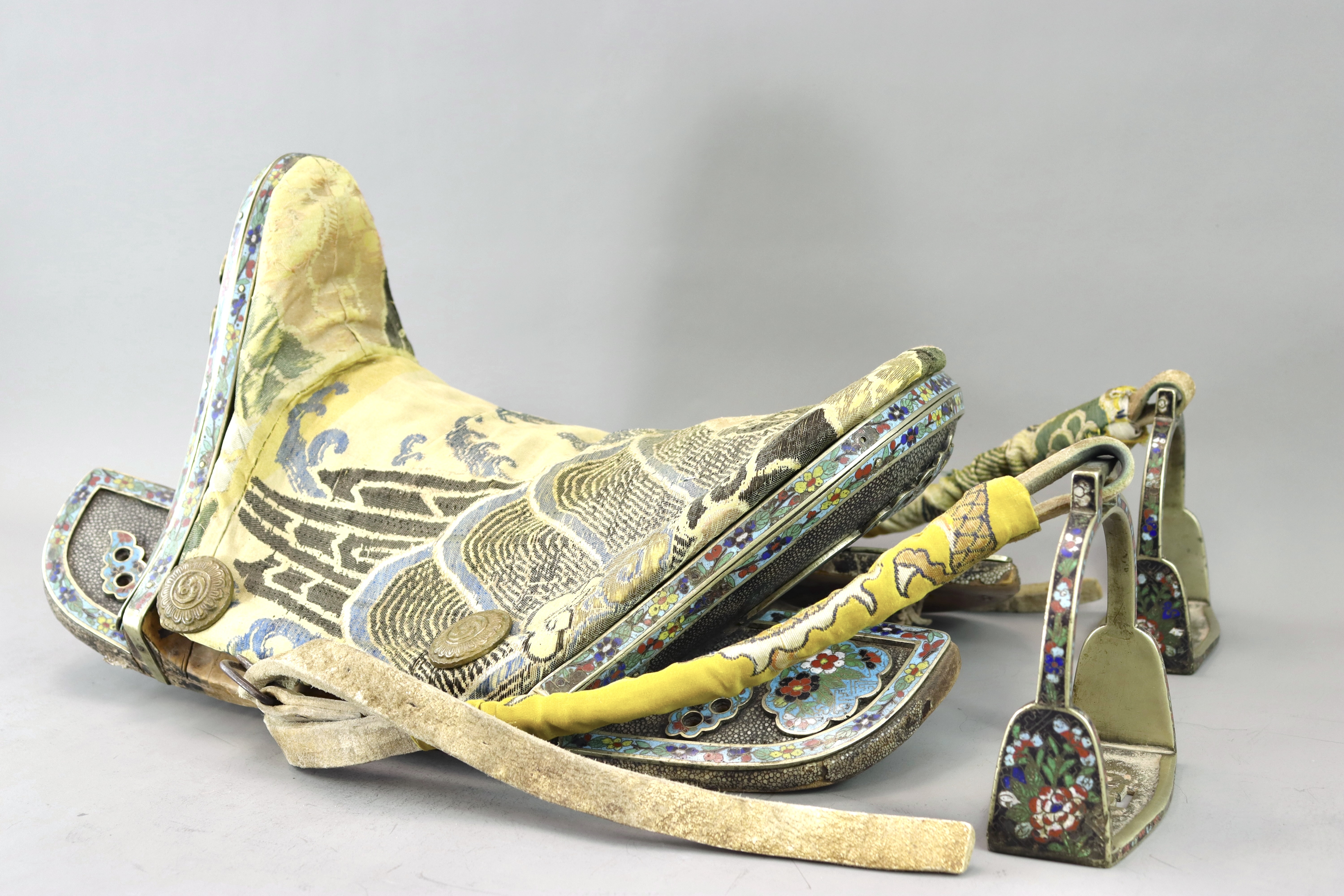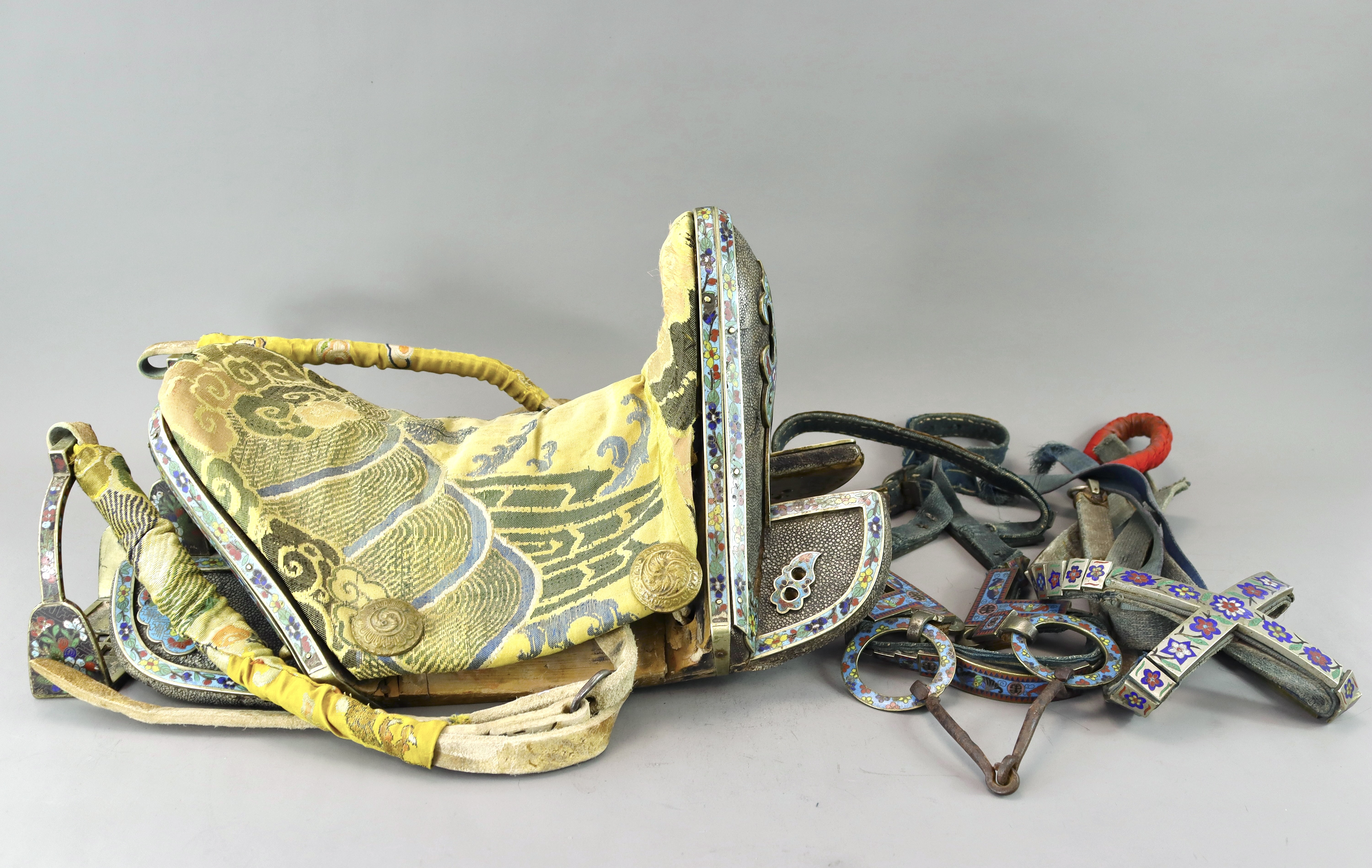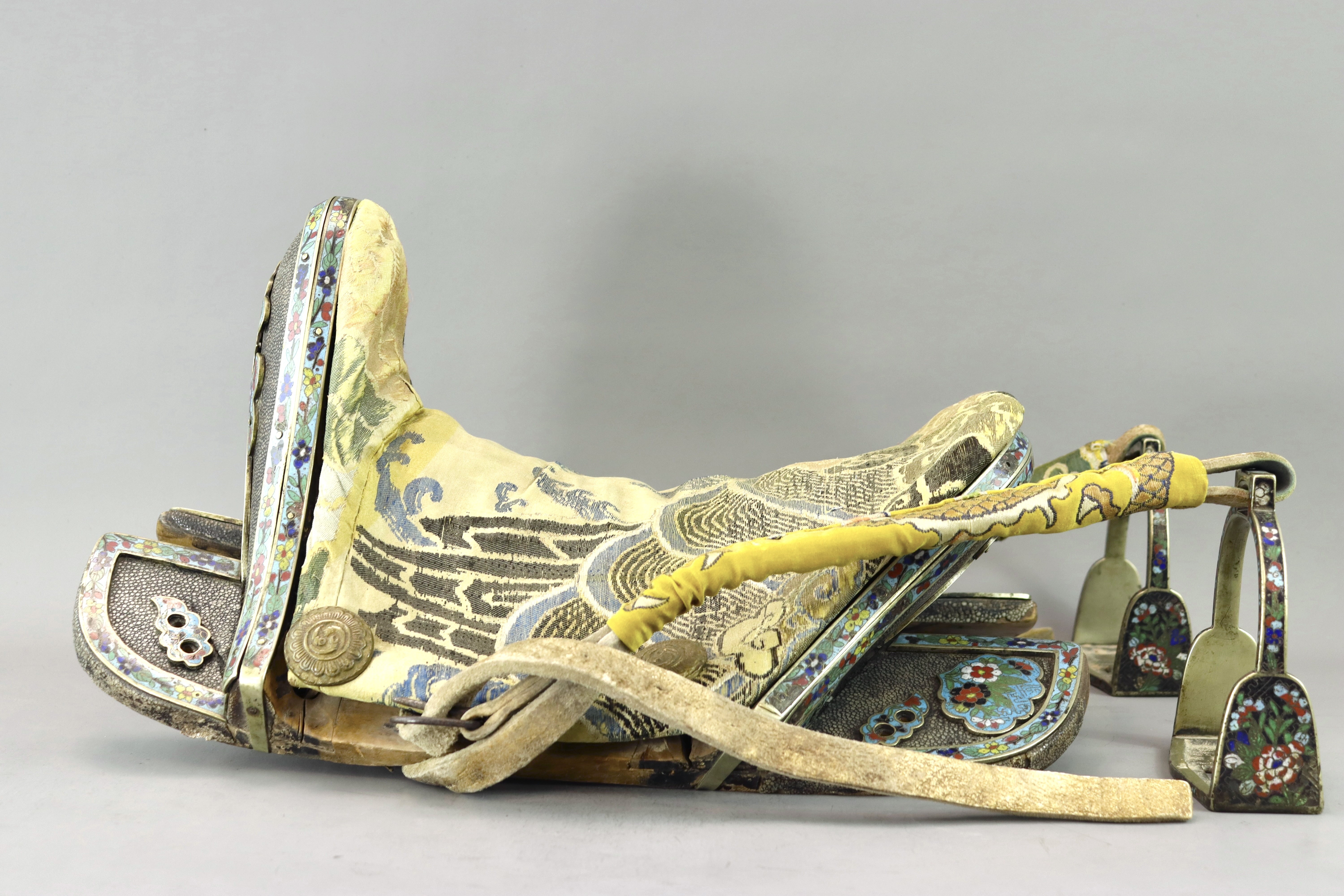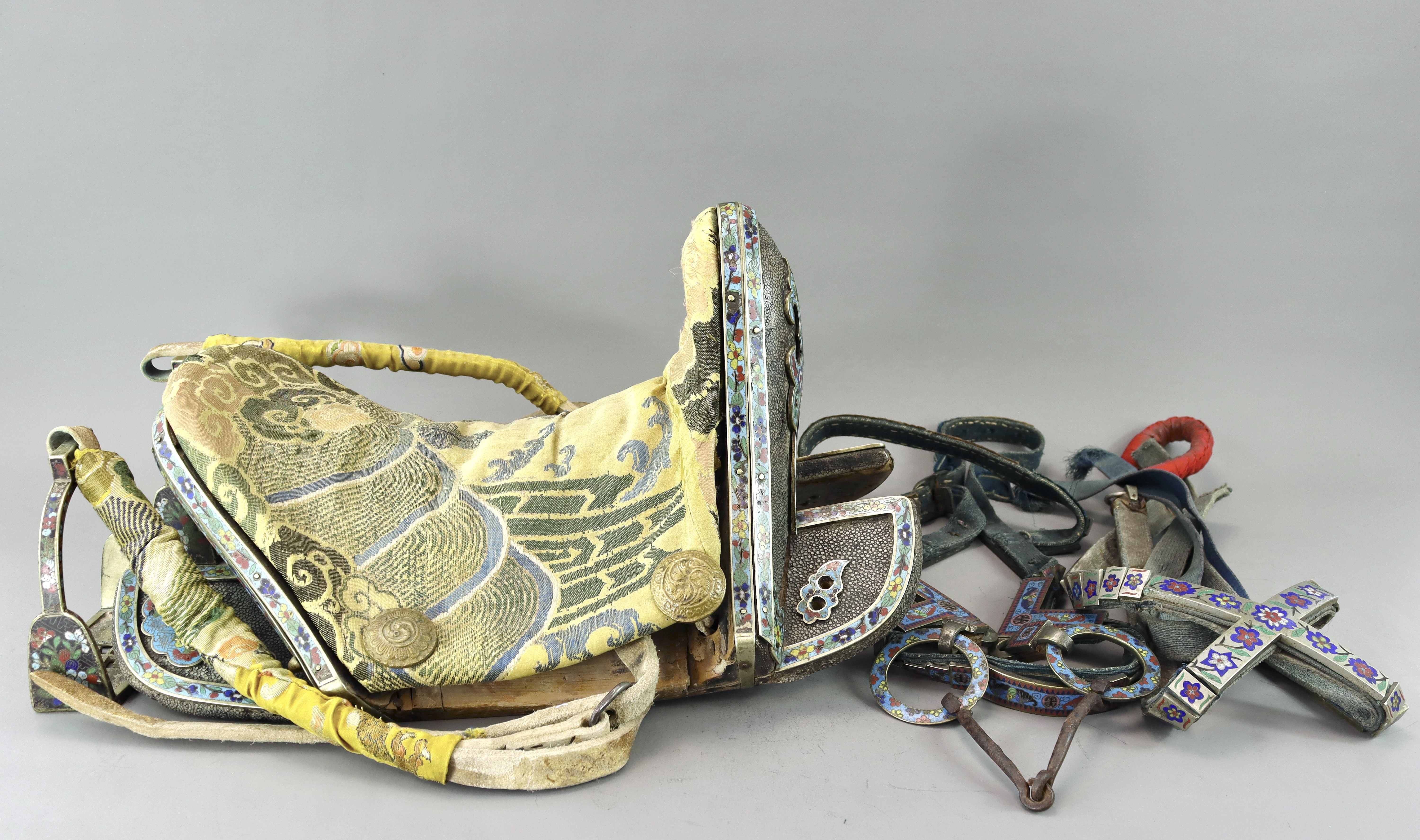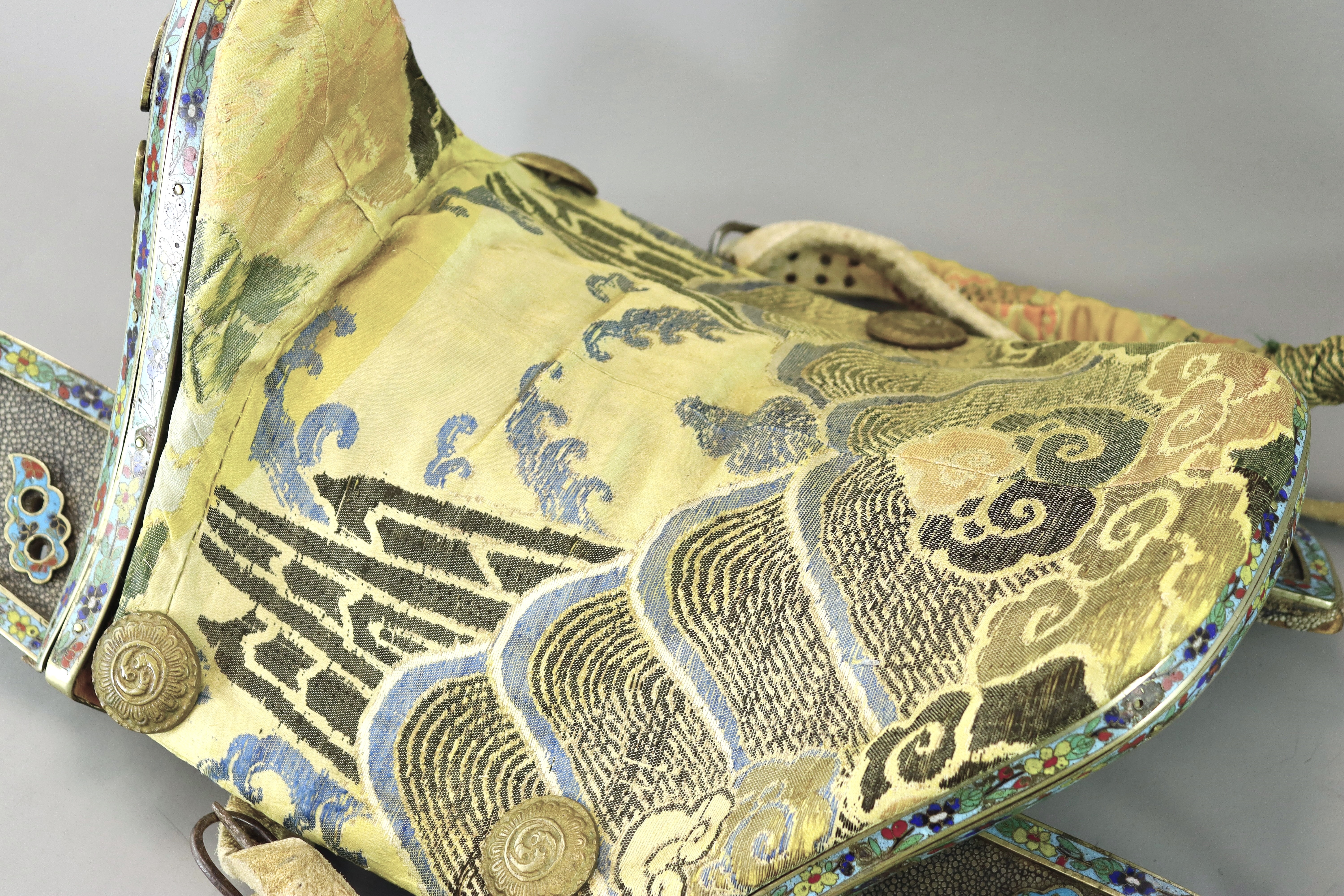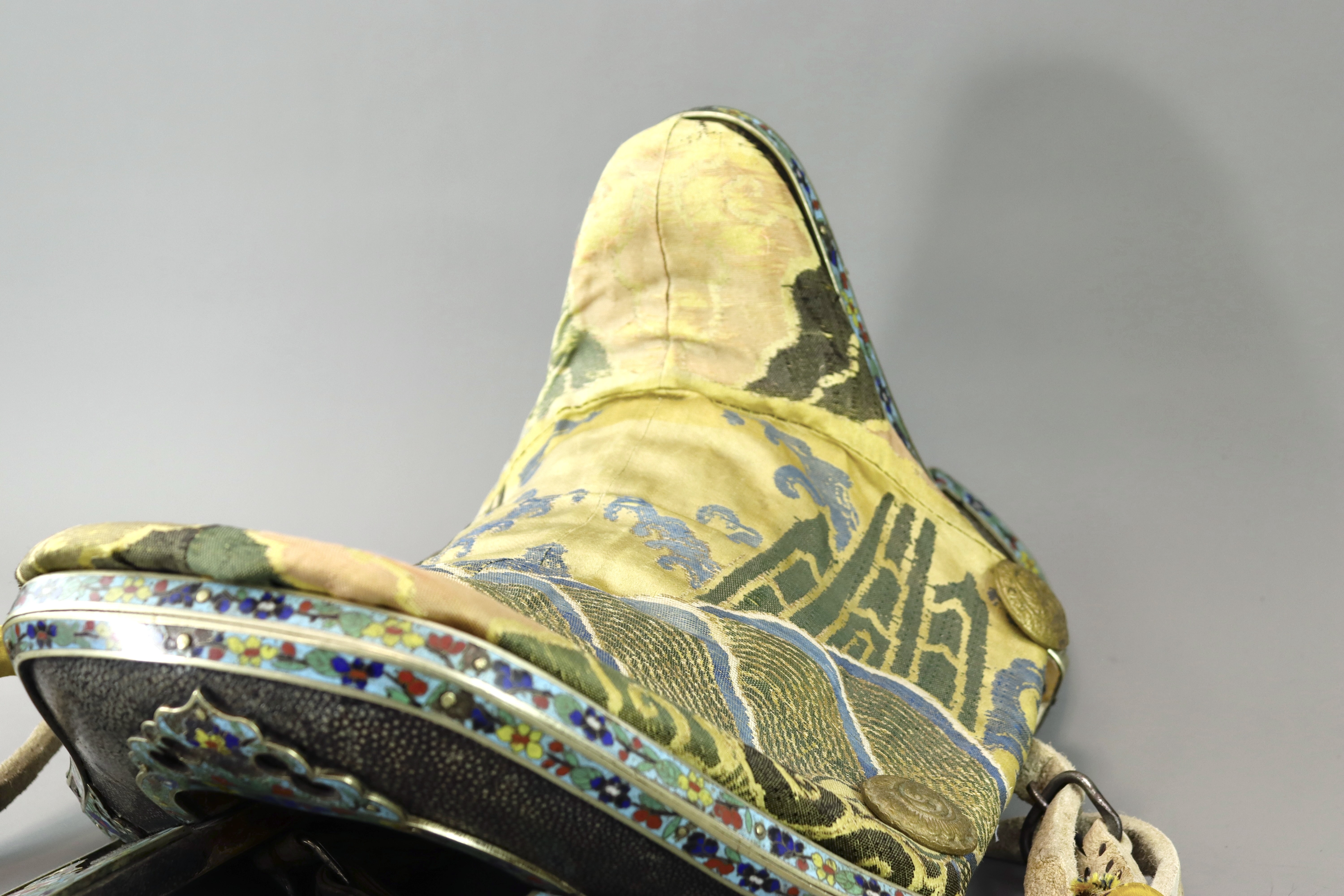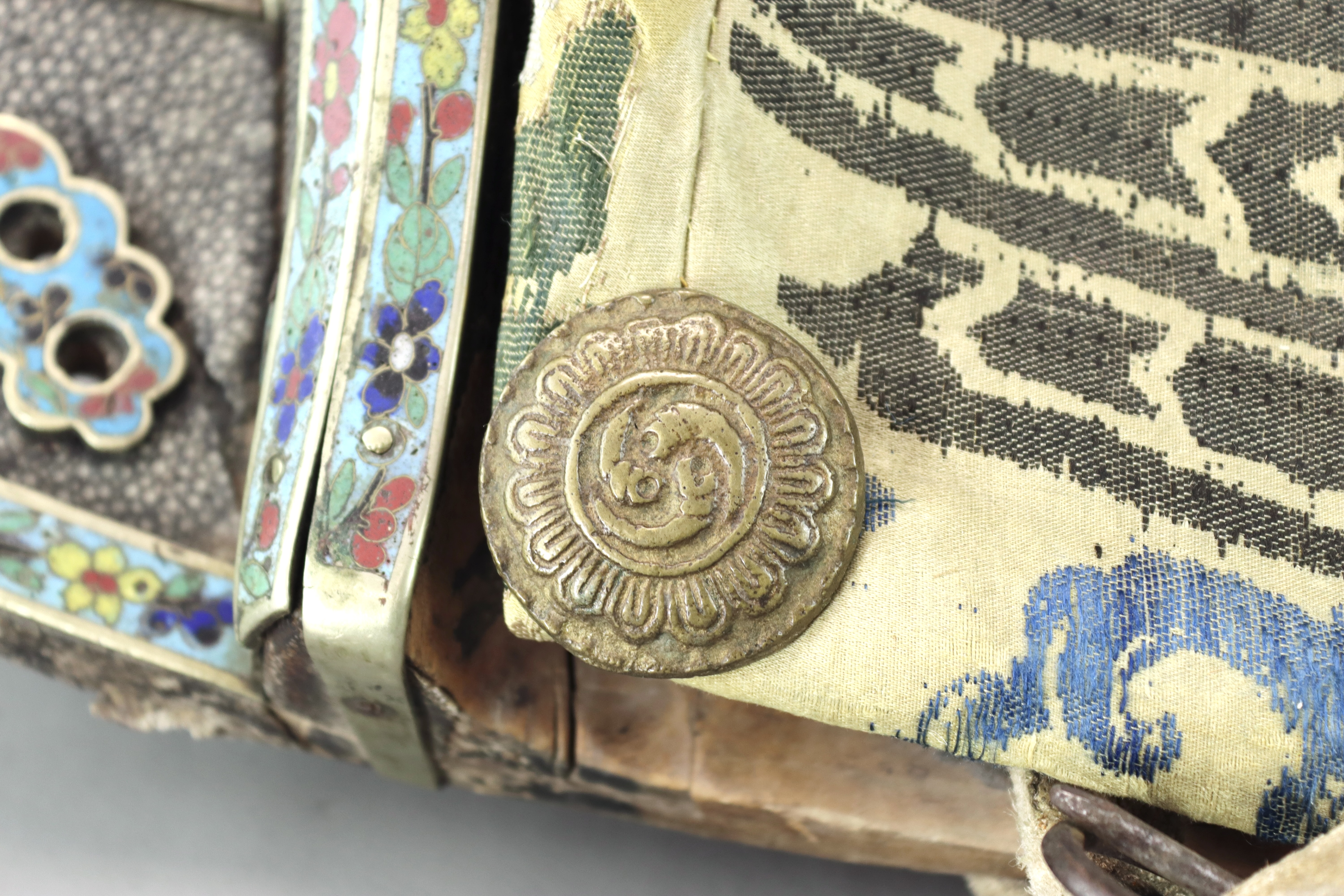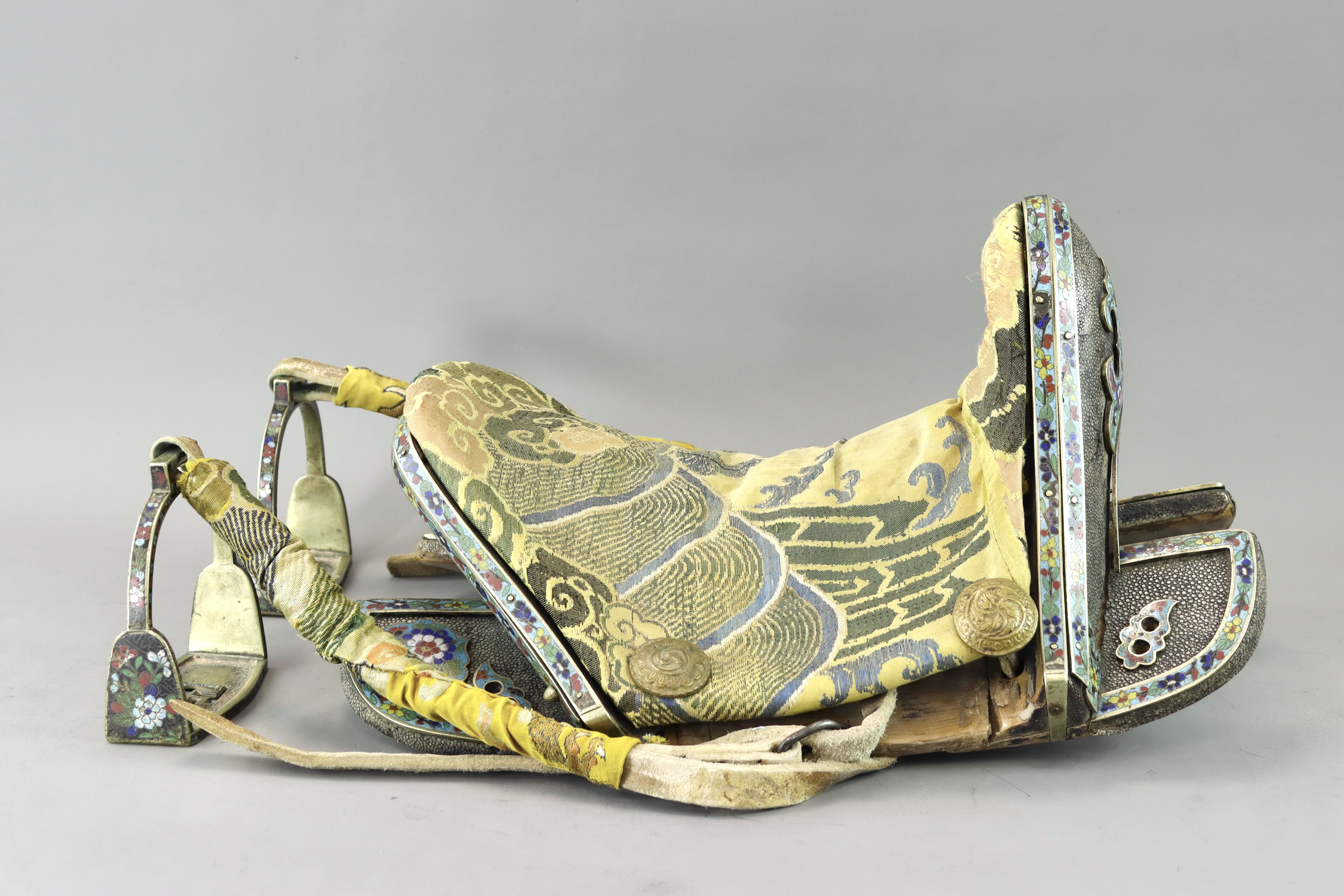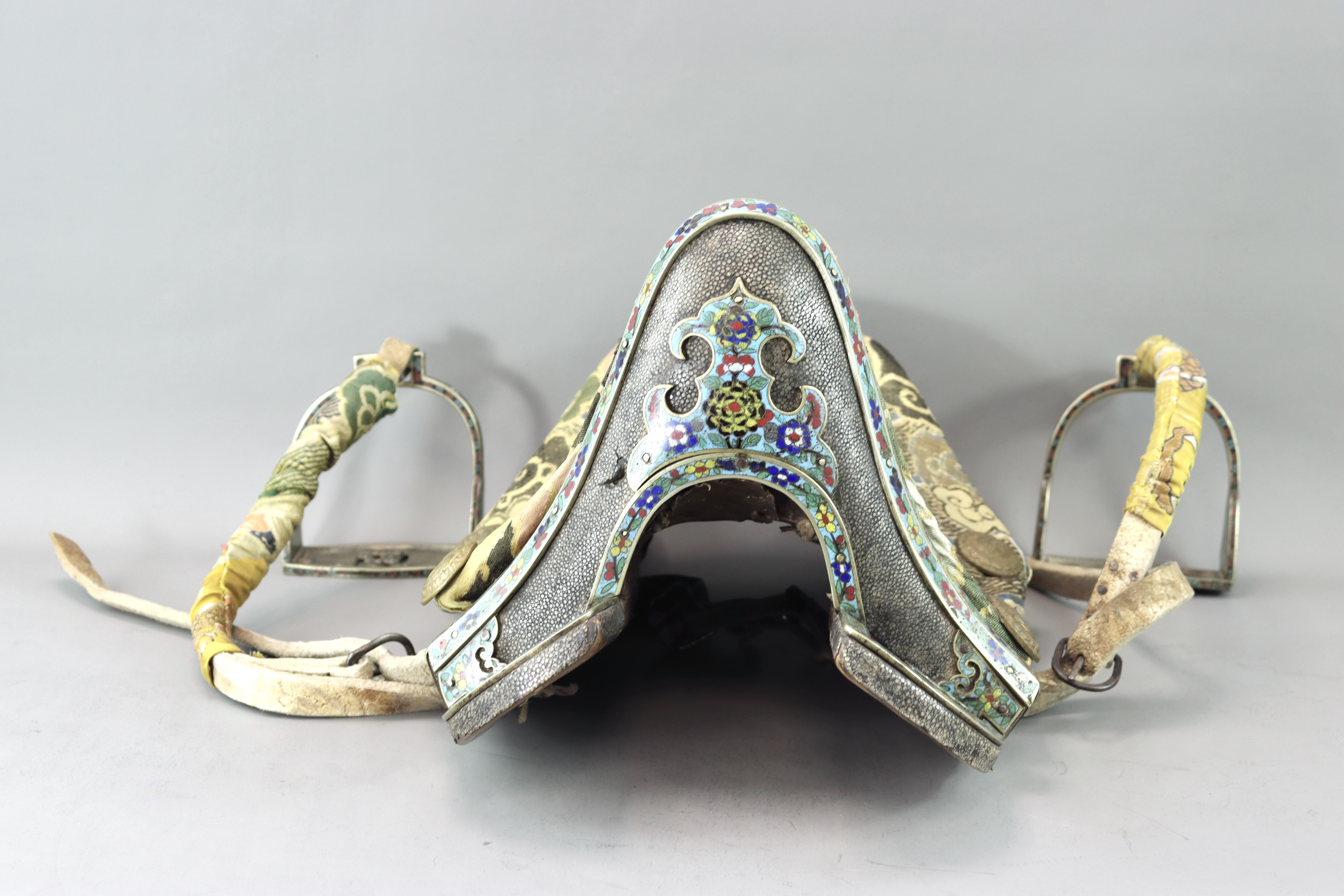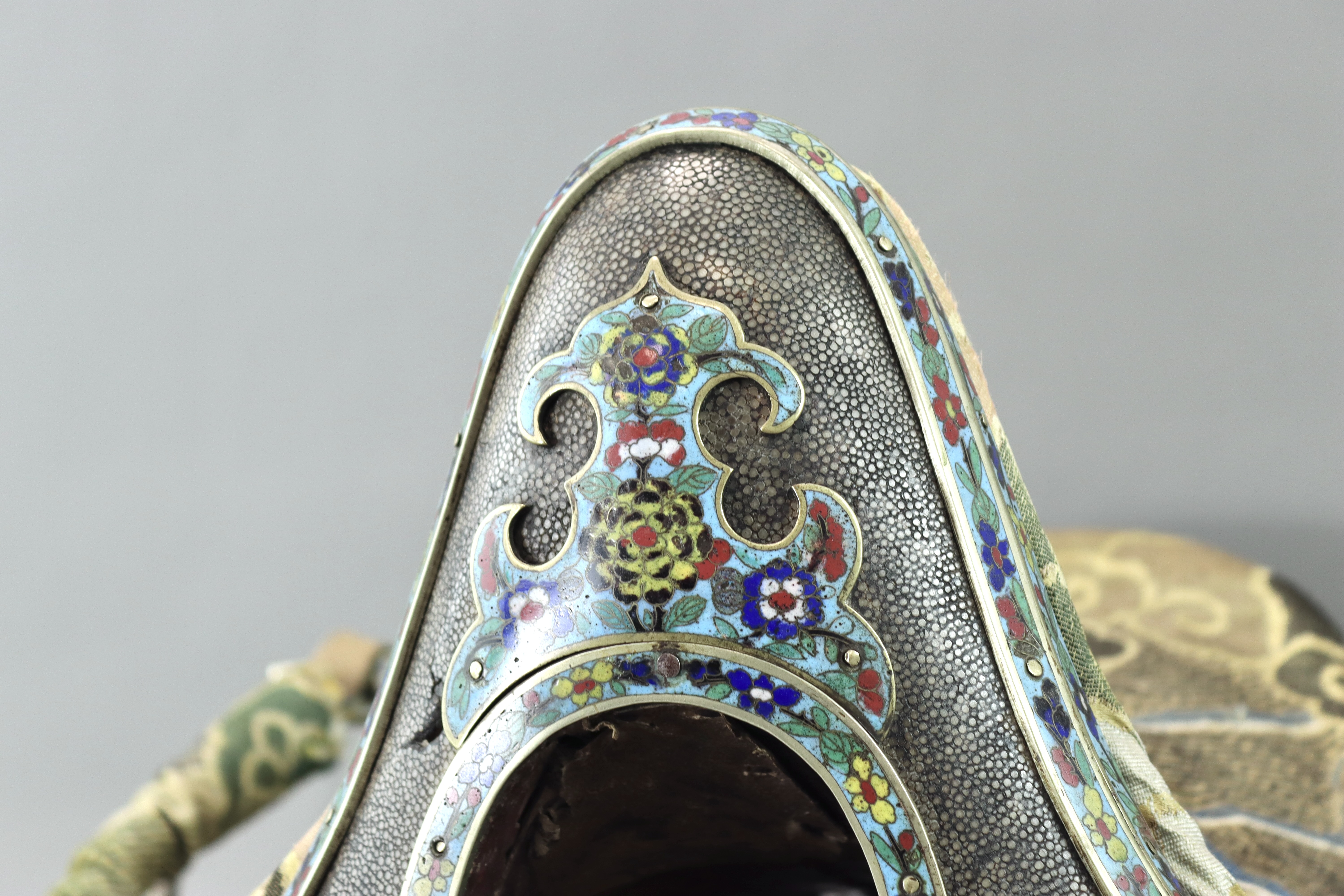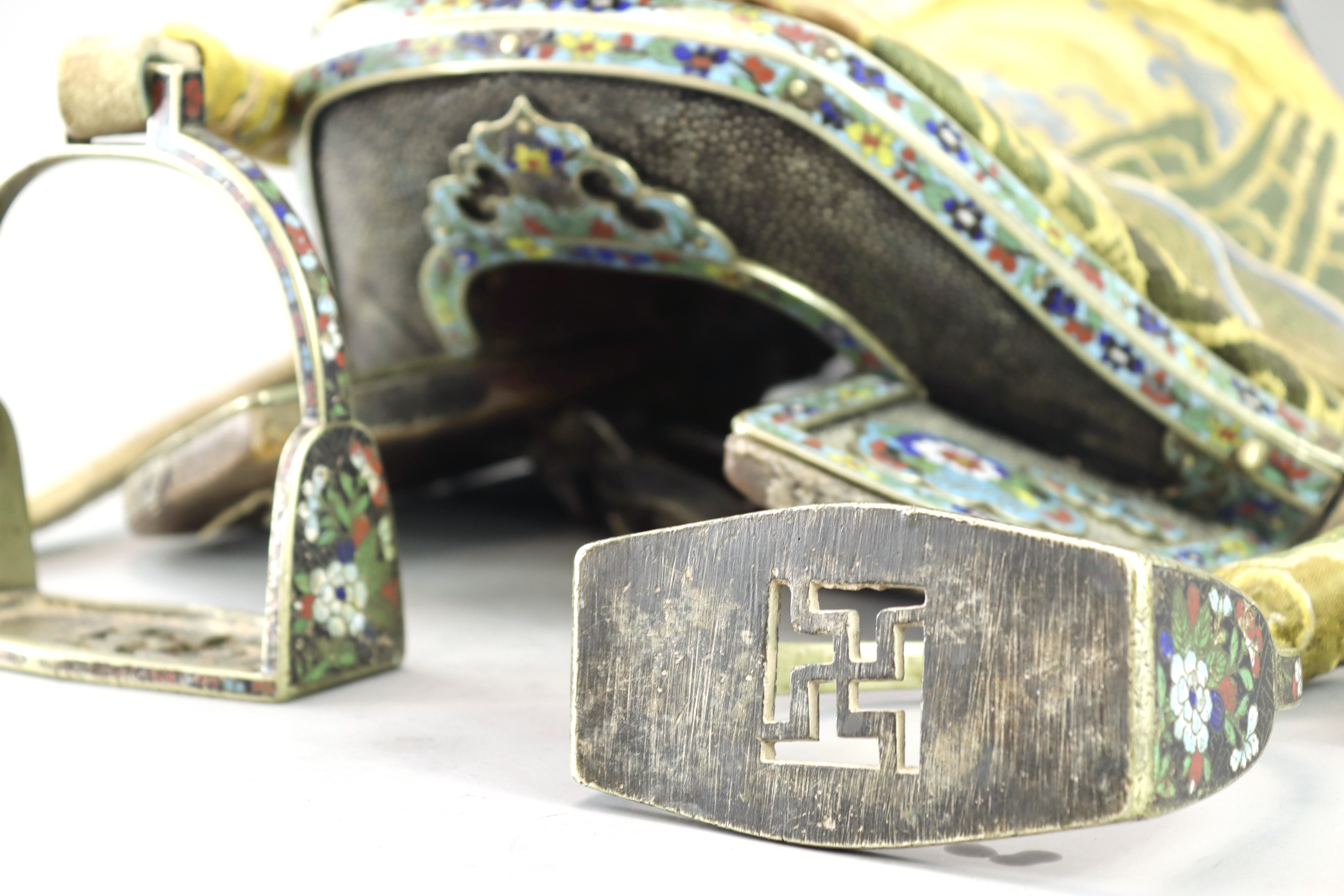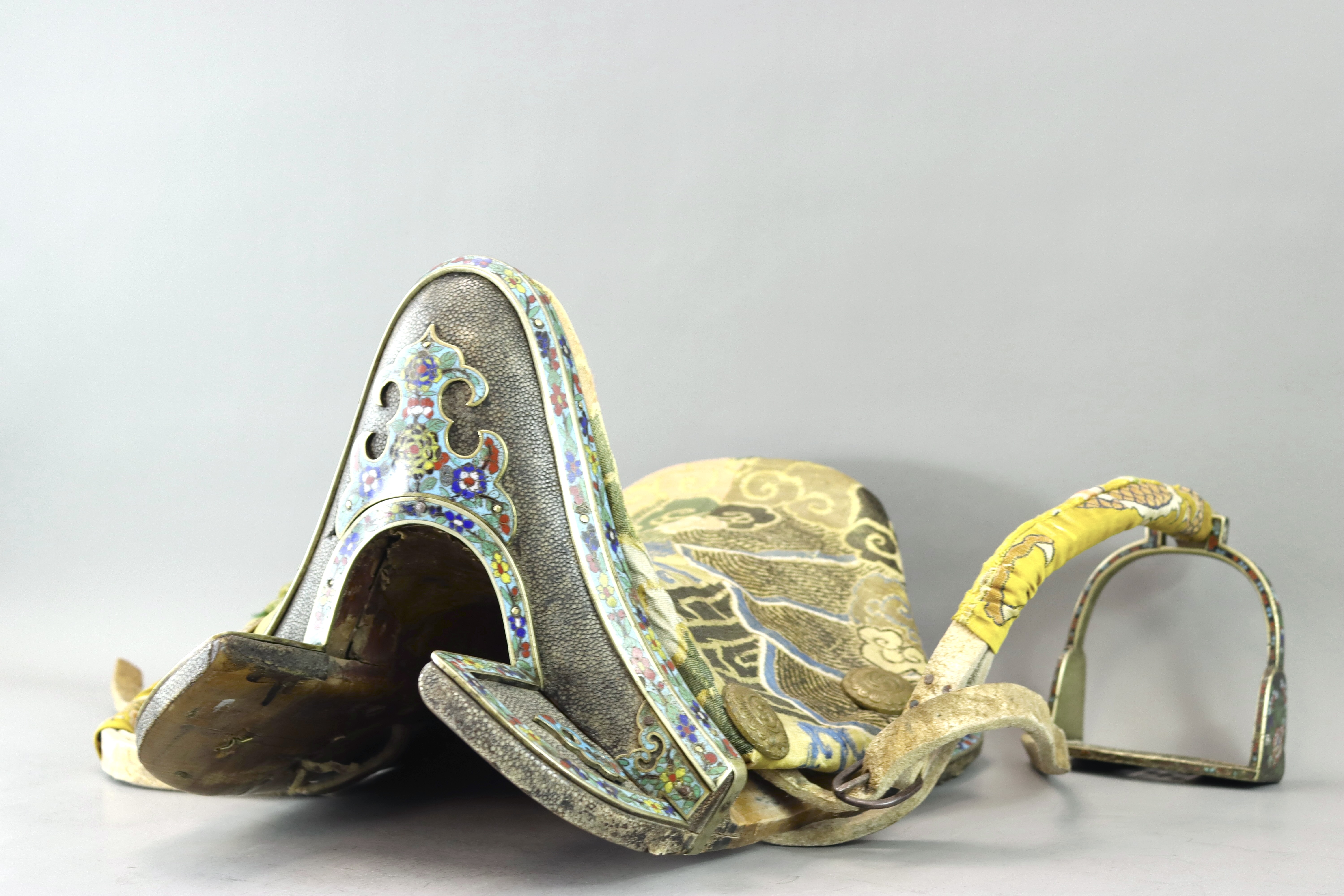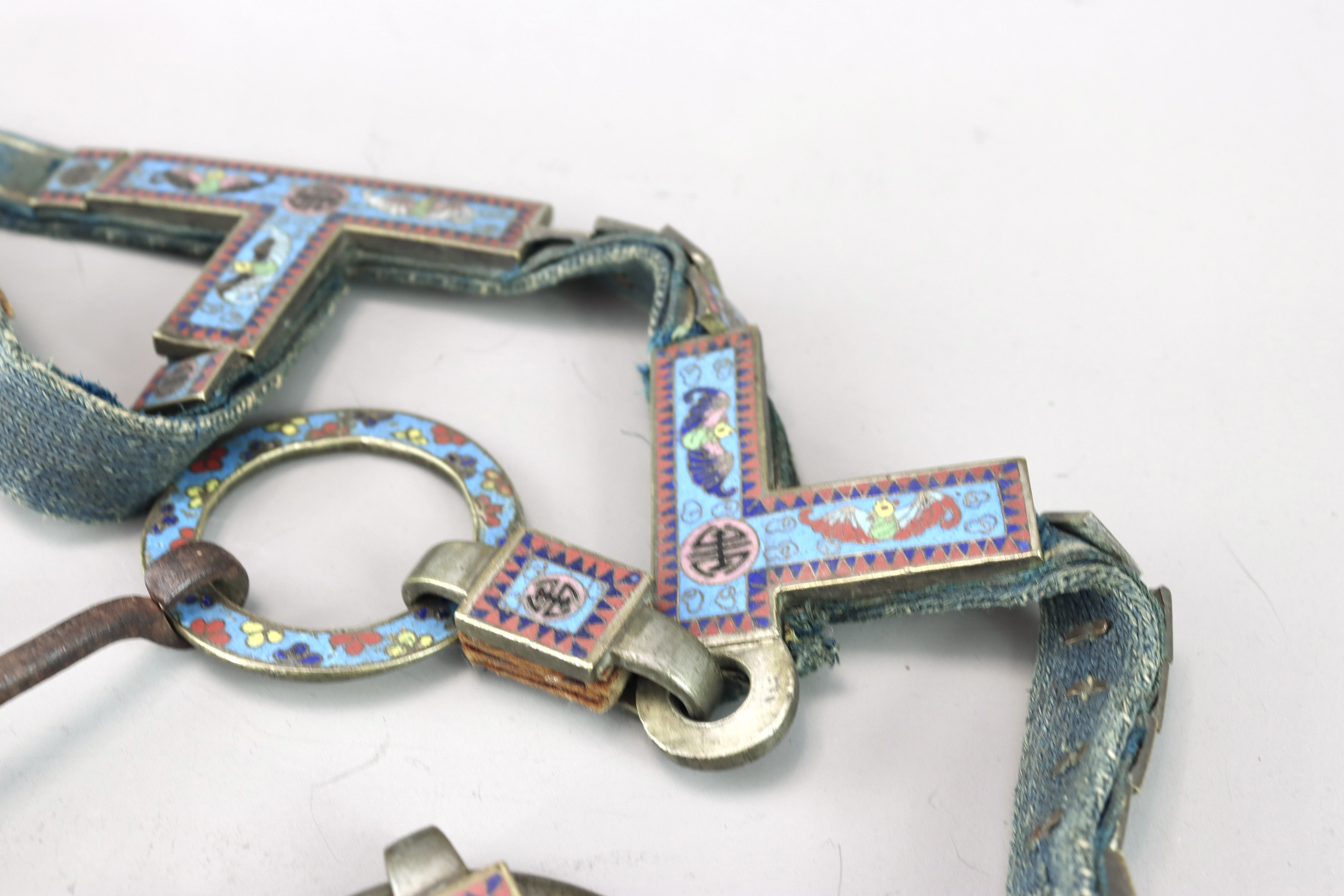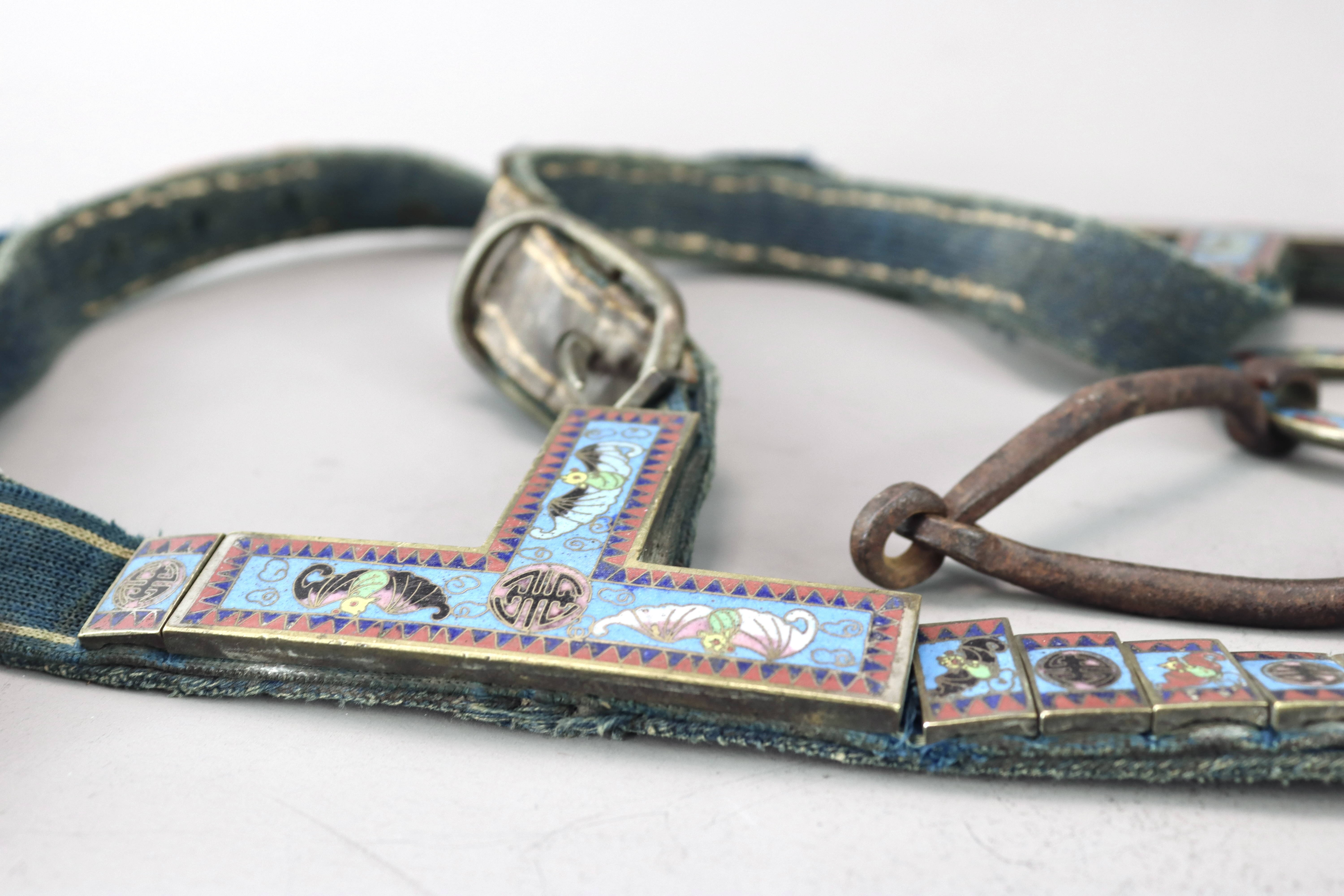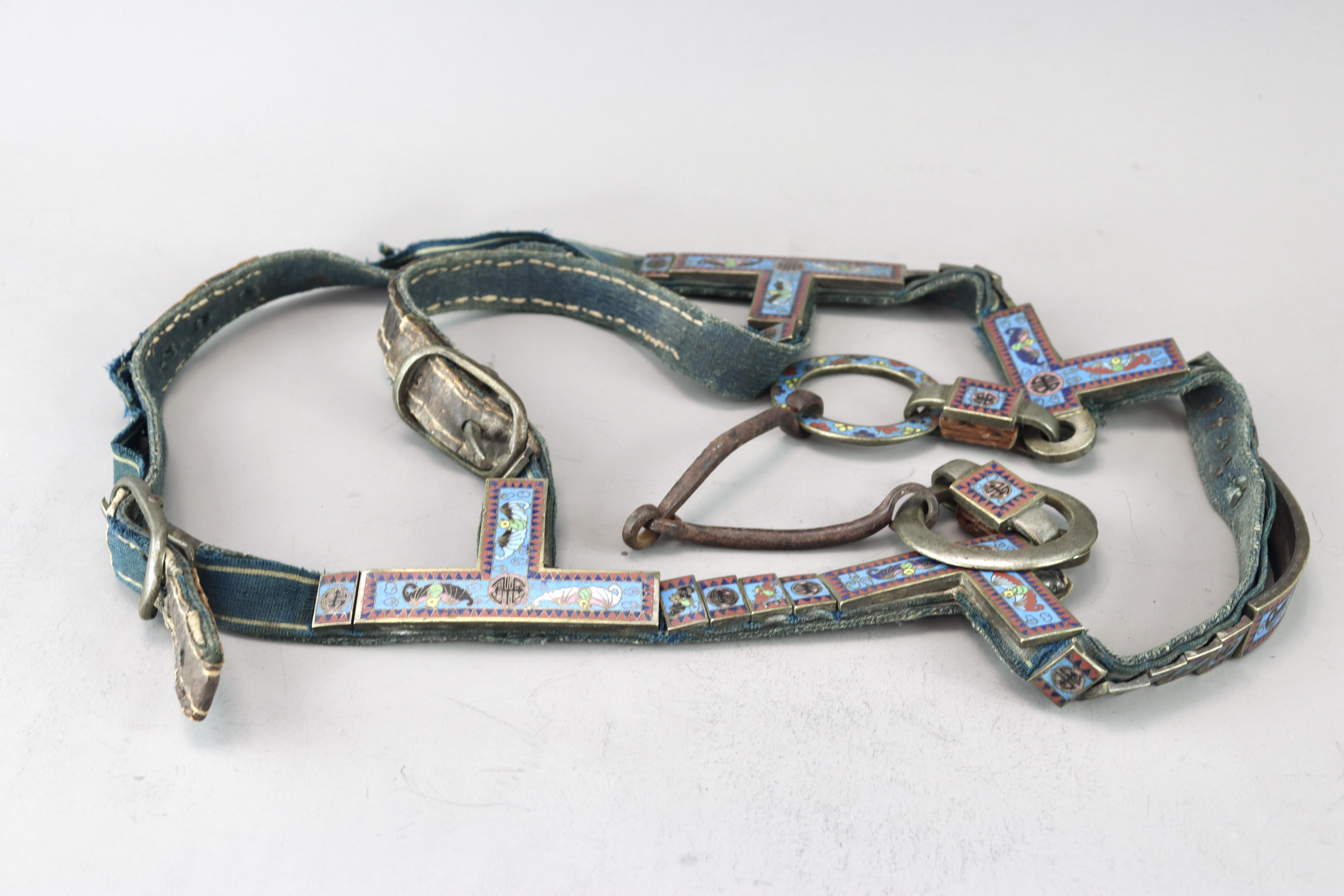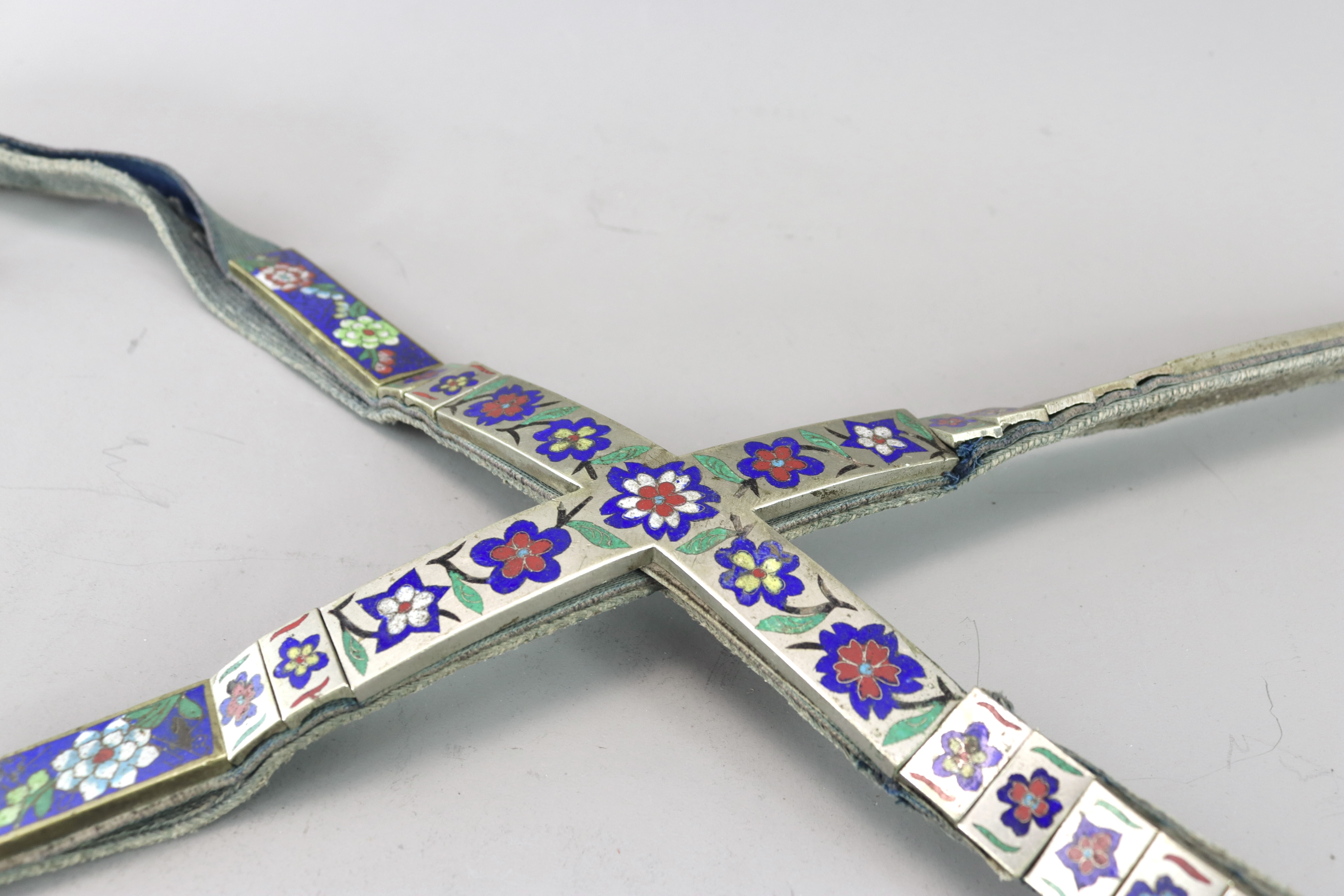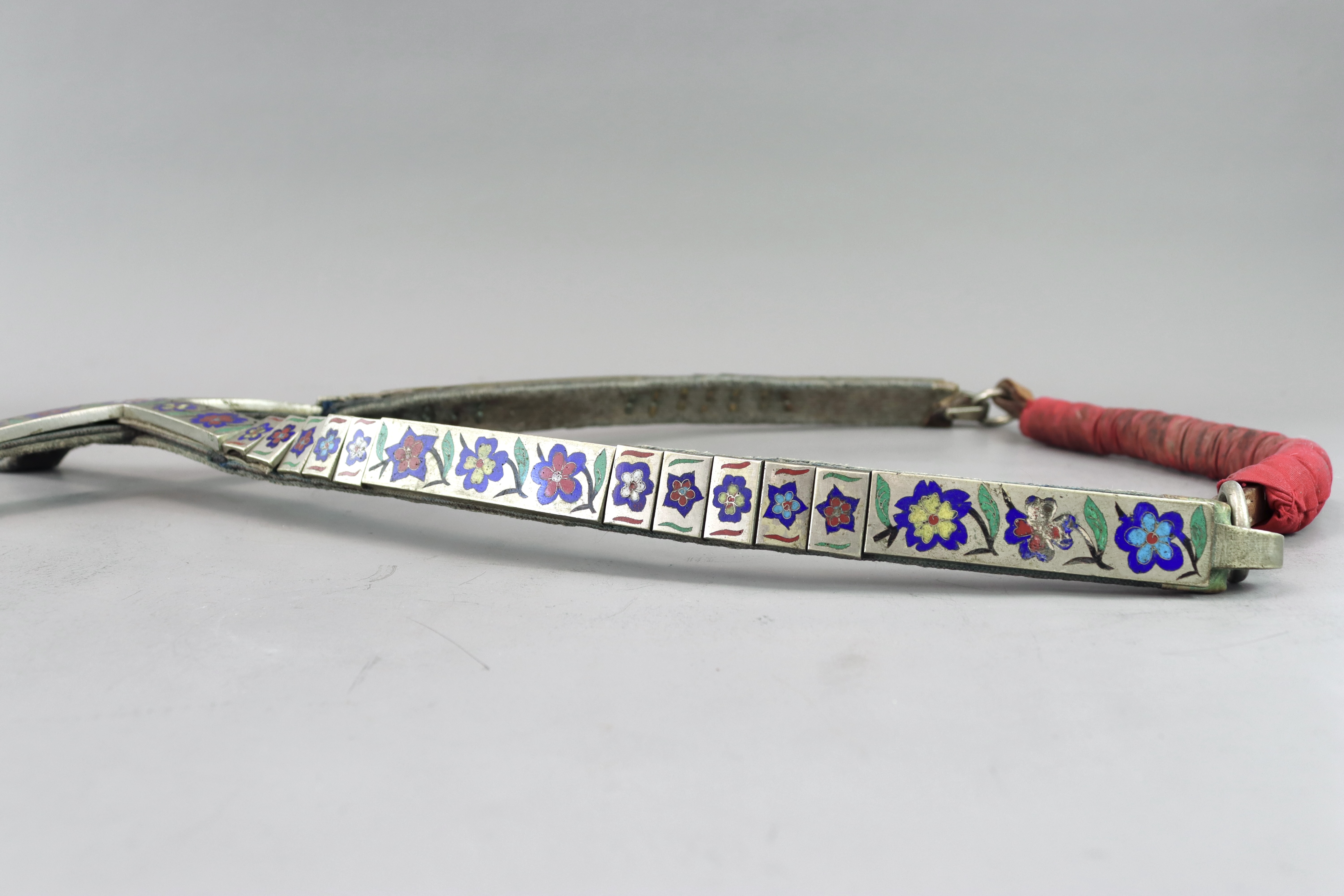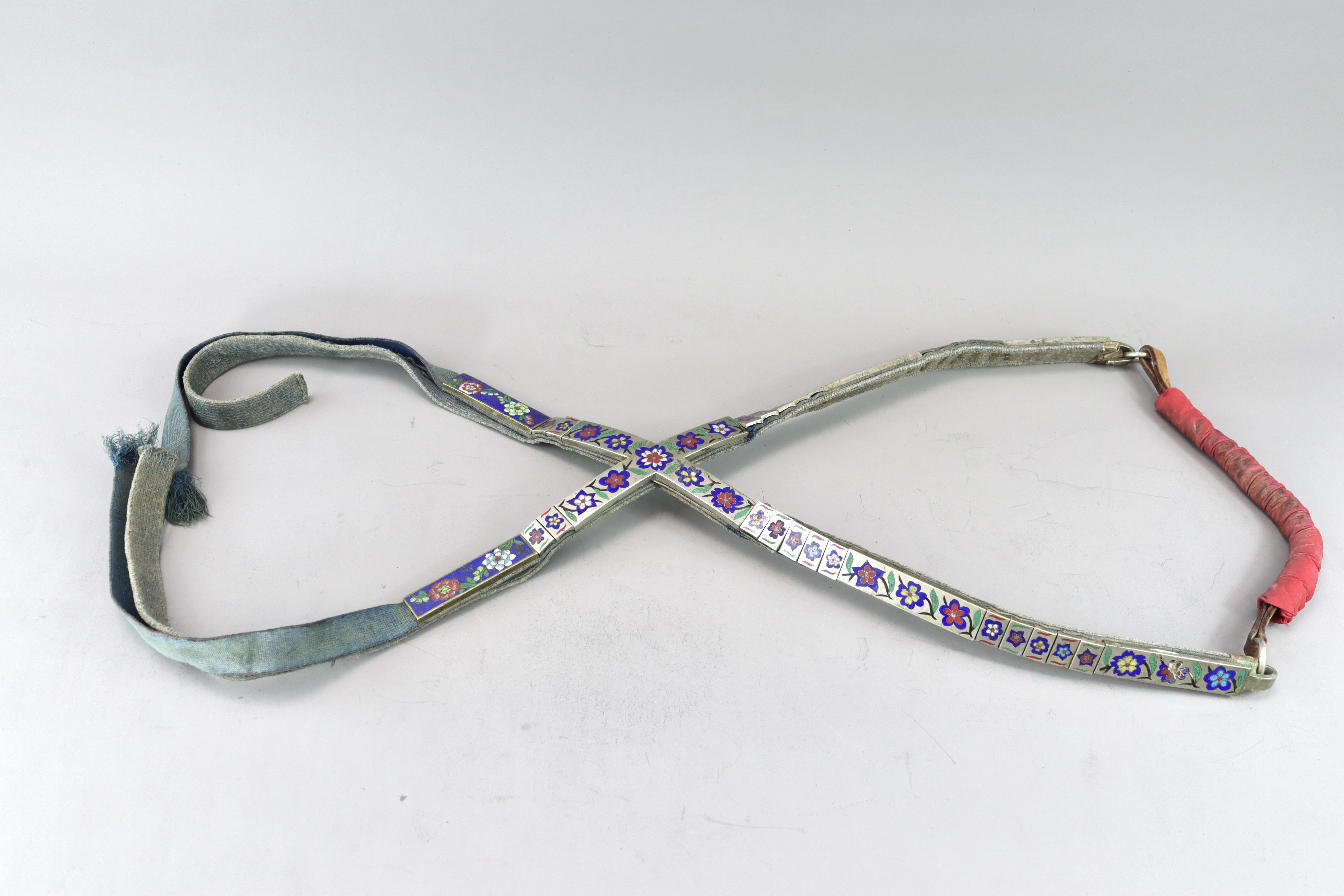442
A Very Rare Imperial Cloisonne Saddle, mid Qing dynasty,
Sie sind dabei, ein Gebot in Höhe von GBP abzugeben.
Startpreis : GBP
Gebote sind ohne Steuern, Aufgeld oder Versankosten.
By confirming your bid, you agree that you have read and accepted the-saleroom.com and the auctioneer's terms and conditions. Confirming your bid is a legally binding obligation to purchase and pay for the lot should your bid be successful.
Please note: you can manage your bids before the auction starts in My Saleroom. Ihr Maximal Gebot kennen nur Sie.
Wählen Sie eine der folgenden Schnellgebotsoptionen:
Gebote sind ohne Steuern, Aufgeld oder Versankosten.
By confirming your bid, you agree that you have read and accepted the-saleroom.com and the auctioneer's terms and conditions. Confirming your bid is a legally binding obligation to purchase and pay for the lot should your bid be successful.
Please note: you can manage your bids before the auction starts in My Saleroom. Ihr Maximal Gebot kennen nur Sie.
making up a very complete set, consisting of a saddle with stirrups, bridle and trappings, the saddle seat faced in yellow silk kesi from a dragon robe, and with cloisonne mounts against a shagreen field, on a birch wood base structure. Note: Birch was considered a hardwood in Northern China, due to the dry winter and wet summer. The structure is composed of four pieces, following Manchu and Mongolian classic tradition. The surface of the front and back parts are covered with Shark- skin and decorated with gilt brass mounts, finely enamelled in cloisonne with floral motifs. The present seat cover epitomises much of the stylistic achievements in embroidery production during the early Qing period, from the smooth yellow ground to the strongly delineated deep brown mountains, and border of ocean waves. As a symbol of the emperor himself, the pattern is a most fitting subject for a saddle destined to grace one of the halls of an imperial palace. The Brass stirrups have treads pierced with a swastika which is considered to symbolise the auspicious footprints of the Buddha. The left-facing swastika is often imprinted on the chest, feet or palms of Buddha images. It is a symbol for the Buddha in many parts of Asia and homologous with the dharma wheel.The shape symbolises the eternal and cyclical, a theme found in the samsara doctrine of Buddhism. The exterior surface enamelled on a Black-ground with floral and geometrical motifs. With a rare horse tail holder, in fabric, with silver 27 mounts, enamelled in polychrome with floral motifs. Together with bridle reins gold-gilt in fabric, with 29 cloisonne mounts, enamelled with bats, birds, longevity symbols and flowers. The bridle rings connect to the iron bit.The bat is a punning rebus for fu meaning fortune or fortunate. Those patterns are very often appear on porclain, furnature, lacquer ware, and cloisonne. . Dimension:Saddle length 45 cm . Condition:. Provenance:Given by Xu Jingcheng to Italian Diplomat, Daniele Vare, in 1891; Collection of Musee du Cheval et de la peronnerie d Art Rene Francois in Beaucaire; Acquired from Roberto Nicola in Milano, 2010.
making up a very complete set, consisting of a saddle with stirrups, bridle and trappings, the saddle seat faced in yellow silk kesi from a dragon robe, and with cloisonne mounts against a shagreen field, on a birch wood base structure. Note: Birch was considered a hardwood in Northern China, due to the dry winter and wet summer. The structure is composed of four pieces, following Manchu and Mongolian classic tradition. The surface of the front and back parts are covered with Shark- skin and decorated with gilt brass mounts, finely enamelled in cloisonne with floral motifs. The present seat cover epitomises much of the stylistic achievements in embroidery production during the early Qing period, from the smooth yellow ground to the strongly delineated deep brown mountains, and border of ocean waves. As a symbol of the emperor himself, the pattern is a most fitting subject for a saddle destined to grace one of the halls of an imperial palace. The Brass stirrups have treads pierced with a swastika which is considered to symbolise the auspicious footprints of the Buddha. The left-facing swastika is often imprinted on the chest, feet or palms of Buddha images. It is a symbol for the Buddha in many parts of Asia and homologous with the dharma wheel.The shape symbolises the eternal and cyclical, a theme found in the samsara doctrine of Buddhism. The exterior surface enamelled on a Black-ground with floral and geometrical motifs. With a rare horse tail holder, in fabric, with silver 27 mounts, enamelled in polychrome with floral motifs. Together with bridle reins gold-gilt in fabric, with 29 cloisonne mounts, enamelled with bats, birds, longevity symbols and flowers. The bridle rings connect to the iron bit.The bat is a punning rebus for fu meaning fortune or fortunate. Those patterns are very often appear on porclain, furnature, lacquer ware, and cloisonne. . Dimension:Saddle length 45 cm . Condition:. Provenance:Given by Xu Jingcheng to Italian Diplomat, Daniele Vare, in 1891; Collection of Musee du Cheval et de la peronnerie d Art Rene Francois in Beaucaire; Acquired from Roberto Nicola in Milano, 2010.
Fine Asian Art
Auktionsdatum
Ort der Versteigerung
Bennett and Dykes do not offer a packing and dispatch service but the following are carriers in our area.
MBE Romford
+44(0)1708 606 535
www.mbe.co.uk/romford
shipping@mberomford.co.uk
Zixis Fine Art Limited
+44(0)7873 981026
www.zixisfineart.co.uk
zixisfineart@163.com
Eric Art Services (UK) Co.. Ltd
+44(203)900 3971
https://eric-art.com
info@eric-art.com
Wichtige Informationen
The sale will further include a wide range of Chinese ceramics and works of art from various owners, including other significant Song ceramics, a private collection of Buddhist bronzes and thangkas, and other highlights, including a finely decorated ruby back Canton enamel dish.
AGB
1. Introduction
The following informative notes are intended to assist Buyers, particularly those inexperienced or new to our new bidding platforms. All sales are conducted on our printed Conditions of Sale which are readily available for inspection and on our website. Our staff will be happy to help you if there is anything you do not fully understand.
2. Agency
As auctioneers we usually contract as agents for the seller whose identity, for reasons of confidentiality, is not normally disclosed. Accordingly if you buy your primary contract is with the seller.
3. Estimates
Estimates are designed to help buyers gauge what sort of sum might be involved for the purchase of a particular lot. The lower estimate may represent the reserve price and certainly will not be below it. Estimates do not include the Buyer's Premium or VAT (where chargeable). Estimates are prepared some time before the sale and may be altered by announcement before the sale. They are in no sense definitive.
4. The purchase price
The Buyer shall pay the hammer price together with a premium. Buyer’s premium is at 25% (plus VAT) below 500,000. At 500,000 or above, it becomes 20% (plus VAT).
5. VAT
The addition of (*) or (VAT applied on hammer price) to the lot description indicates that VAT is payable by the purchaser at the standard rate, presently 20%, on the hammer price as well as being payable on the buyer’s premium. This imposition of VAT is likely to be because the seller is registered for VAT within the European Union and is not operating the Dealers Margin Scheme or because VAT is due at 20% on importation into the UK. Lots which appear without either of the above symbols indicate that no VAT is payable on the hammer price. This is because such lots are sold using the Auctioneers’ Margin Scheme and it should be noted that the VAT included within the premium is not recoverable as input tax.
6. We are, primarily, agents for the seller.
We are dependent on information provided by the seller and whilst we may inspect lots and act reasonably in taking a general view about them we are normally unable to carry out a detailed or any examination of lots in order to ascertain their condition in the way in which it would be wise for a buyer to do. Intending buyers have ample opportunity for inspection of goods and, therefore, accept responsibility for inspecting and investigating lots in which they may be interested. Please note carefully the exclusion of liability for the condition of lots contained in the Conditions of Sale. Neither the seller nor we, as the auctioneers, accept any responsibility for their condition. In particular, mechanical objects of any age are not guaranteed to be in working order. Additionally, in specified circumstances lots misdescribed because they are 'deliberate forgeries' may be returned and repayment made. There is a 3 week time limit. (The expression 'deliberate forgery' is defined in our Conditions of Sale).
7. Electrical goods
These are sold as 'antiques' only and if bought for use must be checked over for compliance with safety regulations by a qualified electrician first.
8. Export of goods
Buyers intending to export goods should ascertain (a) whether an export licence is required and (b) whether there is any specific prohibition on importing goods of that character because, e.g. they may contain prohibited materials such as ivory. Ask us if you need help.
9. Bidding
Bidders may be required to register before the sale commences and lots will be invoiced to the name and address on the registration form. Some form of identification will be required if you are unknown to us. Please enquire in advance about our arrangements for telephone bidding.
10. Commission bidding
Commission bids may be left with the auctioneers indicating the maximum amount to be bid excluding buyers' premium. They will be executed as cheaply as possible having regard to the reserve (if any) and competing bids. If two buyers submit identical commission bids the auctioneers may prefer the first bid received. Please enquire in advance about our arrangements for the leaving of commission bids by telephone, fax or email. It may not be possible to execute bids left on the day of the sale itself.
12. Methods of payment
As a general rule any cheques tendered will need to be cleared before removal of the goods is permitted. Please discuss with our Office in advance of the sale if other methods of payment are envisaged (except cash).
13. Collection and storage
Please note what the Conditions of Sale state about collection and storage. It is important that goods are paid for and collected promptly. Any delay may involve the buyer in paying storage charges.





















































